Brian Clegg's Blog, page 34
September 9, 2019
No Logo revisited - book review
 It's around 20 years since Naomi Klein's book
No Logo
was written (it was published in 2000). As it's generally regarded as an influential piece of writing, I thought it would be worthwhile revisiting it.
It's around 20 years since Naomi Klein's book
No Logo
was written (it was published in 2000). As it's generally regarded as an influential piece of writing, I thought it would be worthwhile revisiting it.At the time, I thought it was an interesting book, if naive and painfully overwritten. Coming back to it, there were two immediate responses. One was to really be aware how much it would have benefitted from a serious edit - it's 490 pages of tiny print and probably only has the content of around five magazine articles. The rest is words for the sake of it and repetition. It's still worth reading, but it's unnecessarily hard work. The other is an element of plus ça change etc.
Inevitably part of the fascination of looking back is what has changed - although some of the big brands remain, others such as Virgin Megastores, Blockbuster, Benneton and Staples have disappeared or diminished, while the likes of Google weren't on the radar then. And neither Klein's anti-brand rebellion nor some of the nasty brand trends foreseen have come about.
I must admit, in part because it's such a US-oriented book, I didn't recognise some of the problems discussed, e.g. branding in schools, while branded stores becoming theme park-like destinations have never really happened over here.
It was interesting that one of Klein's bugbears was corporate censorship - for example, supermarkets deciding not to carry a particular magazine because they didn't like its ethos - when such censorship is now more likely to come from student unions.
It certainly isn't all bad. No Logo is a useful reminder of how relatively recent the move from vertical manufacturing, where companies made their own goods, to brand plus suppliers has been - and the potential problems this approach can bring (which haven't gone away). It's also good and still very relevant, given the 'gig economy', in the way that Klein points out that being freelance is good for some types of job, but is far from being a panacea.
Overall, though, bearing in mind our greater awareness now of social media bubbles, what came across strongly was how much of a bubble view of the world it was. So, taking on the two main UK stories covered, one was about the McLibel trial and the other about Reclaim the Streets. The McLibel trial had real impact on the relationship between corporates and activists and, while a farce, probably did a fair amount of good. But if you took Klein's picture of Reclaim the Streets (a few 'street parties' that stopped traffic as Extinction Rebellion has more recently), you would think it had transformed UK opinion, where the majority of the population away from a few fashionable bits of London and the odd trendy city were pretty much unaware of it at the time, let alone now. Nothing happened, except some irritating disruption.
Despite that bubble view, though, it's an important bit of US-centred social history and reminds us that we continue to need to keep an eye on those pesky corporations.
No Logo is available from Amazon.co.uk and Amazon.com which is by far the most ironic place to purchase it.
Published on September 09, 2019 03:57
August 26, 2019
On making an unexpected visit to Lille
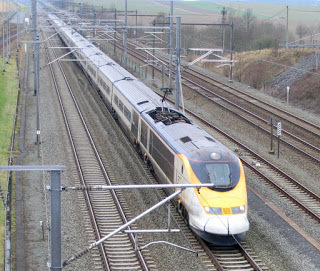 I was recently in Lille, and the most entertaining thing there was watching a pair of rats fight each other.
I was recently in Lille, and the most entertaining thing there was watching a pair of rats fight each other.While that statement's true, it's rather unfair to Lille. I am biassed, as I had no intention to be in Lille (other than passing through). To be precise, I was on the Eurostar train from Brussels to London. Things didn't start brilliantly, but at Lille they went spectacularly wrong.
We had left Brussels about an hour late, allegedly because an electrical problem meant that the check-in went down for a few minutes. (It wasn't clear why this fault, which happened when most of the travellers had already checked-in, should stop everyone boarding, but that's how it went.) But we were soon in Lille, where we were joined by a bunch of people from Disneyland Paris (so quite a lot of young travellers) and expected to be whisked off at 200 mph any time soon. Only, we weren't.
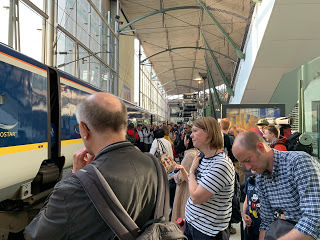 Waiting on the platform after being turfed offWe sat in the train for some time, before the inhabitants of coaches 10 to 18 were asked to get off the train, taking all their luggage with them. This was apparently because there was a 'trespasser' on the train. As might be imagined, it took quite a while for nearly 700 passengers to disembark, whereon we stood around on the platform for about half an hour, during which time the main entertainment was people suddenly realising that they really did need to take their bags off and nipping back on to get them while being shouted at by staff. This climaxed with a Eurostar staff member casually carting a large rucksack around, asking if it belonged to anyone (apparently not concerned that it might be a suspicious item).
Waiting on the platform after being turfed offWe sat in the train for some time, before the inhabitants of coaches 10 to 18 were asked to get off the train, taking all their luggage with them. This was apparently because there was a 'trespasser' on the train. As might be imagined, it took quite a while for nearly 700 passengers to disembark, whereon we stood around on the platform for about half an hour, during which time the main entertainment was people suddenly realising that they really did need to take their bags off and nipping back on to get them while being shouted at by staff. This climaxed with a Eurostar staff member casually carting a large rucksack around, asking if it belonged to anyone (apparently not concerned that it might be a suspicious item).Eventually, they opened the doors to the upper floor, and we gradually shuffled up, across the Lille concourse past bemused ordinary train travellers to the Eurostar check-in, where we had to show our tickets and go through security and both French and UK passport control again. (Interestingly given we'd been through Belgian and UK passport control in Brussels, so were technically in the UK when on the train, we must have magically travelled from the UK to France when we were allowed off the platform.)
 Not bad emergency rationsWe then entered the Eurostar lounge, where there was a huge pile of cardboard boxes, containing quite a generous set of emergency rations. And there we sat for some considerable time, with the aforementioned fighting rats outside the window (bouncing around amazingly) for entertainment. After a while, the other half of the train also entered the lounge which was therefore both very hot and seriously overcrowded with around 1,400 stoic travellers in it.
Not bad emergency rationsWe then entered the Eurostar lounge, where there was a huge pile of cardboard boxes, containing quite a generous set of emergency rations. And there we sat for some considerable time, with the aforementioned fighting rats outside the window (bouncing around amazingly) for entertainment. After a while, the other half of the train also entered the lounge which was therefore both very hot and seriously overcrowded with around 1,400 stoic travellers in it.After an hour or two (I'm not sure exactly how long, though the train eventually arrived in London 4 1/4 hours late) the doors from the lounge onto the platform opened and we shuffled back onto the train.
In many ways, Eurostar handled this well, but the huge error, which seems so common when travel customer service goes wrong, was the total lack of communication. Once we entered the lounge there were no announcements. No one spoke to us. Even when we went back onto the train, it was just a case of noticing people starting to move - there was no information whatsoever. We never heard how the 'trespasser' got on the train.
The lesser complaint was that the compensation was pretty meagre. I recently had a several hour delay at Paddington (coincidentally also due to to trespassers, though this time on the line) and GWR compensated me by fully refunding my return ticket. Eurostar gave us 50% of the one way fare. And, like many others, we had missed our onward connections, which aren't covered. The worst we heard of was a troupe of child dancers who missed the last train to Liverpool and had to find accommodation in London for the night.
Communication is the absolute lifeblood of good customer service. Eurostar have demonstrated (as airlines also so often do) that failing to communicate does not leave you in a good light. Get your act together, guys.
Published on August 26, 2019 01:49
June 24, 2019
Review: Cobblestone - streaming music with style
 Cobblestone in the wildThese days I stream most of the music I listen to, which leaves me with a bit of a quandary. I can listen to music on my computer or TV soundbar with reasonable quality, or my phone or Echo speakers with so-so quality. But I have a perfectly good old hi-fi system with really rather nice Monitor Audio speakers that sits there doing very little.
Cobblestone in the wildThese days I stream most of the music I listen to, which leaves me with a bit of a quandary. I can listen to music on my computer or TV soundbar with reasonable quality, or my phone or Echo speakers with so-so quality. But I have a perfectly good old hi-fi system with really rather nice Monitor Audio speakers that sits there doing very little.I used to use an Apple Airport Express, and then a Neet Airstream, which joined my network and allowed me to play music from iTunes on my computer to the device - but the Airstream has given up the ghost, and it was always a restrictive way of operating.
Now, though, I've picked up a Cobblestone and couldn't be happier.
It's a rather elegant device, shaped and textured like a flat pebble. In principle it's very similar to the Airstream - it connects to the Aux In of my hi-fi and music gets to it via wi-fi. (There's a lot of -fi around.) However it's much clever in its support of the technology. I can play direct from within Spotify, or I can use Airplay to play from pretty much any music source on my phone, tablet or computer - I tried it with both the Apple Music app/iTunes and Primephonic and they all worked fine. It simply does the job, very neatly.
As a nice little extra, the box has track/play-pause/forward a track sensors on the front (rather faint, though they light up if you touch them) so you can do simple play control from it directly, though more often than not I imagine I would do the controlling from my phone.
It's simple, not highly expensive (around £39) for something that brings back to use a significantly more expensive piece of kit and does the job well. What's not to like?
Cobblestone is available from Amazon.co.uk
Published on June 24, 2019 08:04
June 23, 2019
To Primephonic or not to Primephonic...
 To Primephonic or not to Primephonic... that is the question.
To Primephonic or not to Primephonic... that is the question.Like many others, while generally impressed with Spotify, I have struggled with some aspects of it when it comes to playing 'classical'* music. Spotify is totally oriented to songs, where much classical music is in the form of a piece consisting of several parts or movements, which are usually provided as separate tracks.
Similarly, in classical music, the composer is a key part of the information - more so than the performer - where in Spotify's songs it's very much performer to the fore. In fact, some of these issues aren't even limited to traditional classical music - I am very much a child of prog rock, and prog rock albums are made to be played as albums, not individual tracks.
I was, therefore, really please when a Facebook query by Emma Darwin brought to my attention Primephonic - a streaming service specifically oriented to classical music. I've had a two month free trial and I'm very impressed.
 The dreaded Shuffle Play buttonPrimephonic has an impressive classical database and is very much organised around pieces, composers and albums, rather than tracks. It has a good discovery section with new albums, recommendations 'from the archive' and reasonable curated playlists for discovery in various genres. The music sounds great and if you, say, suddenly get the urge to listen to any specific classical piece, it's less fiddly than doing so with Spotify. Perhaps best of all, where Spotify on the phone only has a 'Shuffle Play' button, the Primephonic app has a straight Play button, so you don't suddenly find movement two coming after movement four.
The dreaded Shuffle Play buttonPrimephonic has an impressive classical database and is very much organised around pieces, composers and albums, rather than tracks. It has a good discovery section with new albums, recommendations 'from the archive' and reasonable curated playlists for discovery in various genres. The music sounds great and if you, say, suddenly get the urge to listen to any specific classical piece, it's less fiddly than doing so with Spotify. Perhaps best of all, where Spotify on the phone only has a 'Shuffle Play' button, the Primephonic app has a straight Play button, so you don't suddenly find movement two coming after movement four.Audiophiles can also pay a bit more for really high spec streaming - but I'm a bit of philistine in this respect, as I never play music on any equipment good enough to really care.
The Primephonic pricing is comparable with Spotify. So for a while, I genuinely thought that I might stay with Primephonic. But actually, at the end of my trial, I'm switching back to Spotify. Here's why.
Firstly, I don't just listen to 'classical' music - it's probably 50:50 depending on mood. Primephonic only delivers the classical side, so I'd probably need both if I were to stick with it, which stretches the budget.
 The more civilised Mac appSecondly, I can get round Spotify's issues. More often than not I play music from the computer, rather than a phone - and on the computer, there is a nice fat 'Play' button, rather than 'Shuffle Play.' (Note to Spotify - please give the option of having this on the phone for a paid account!) But even on the phone you can play an album without shuffling - just ignore the main Shuffle Play button, start the first track directly and make sure the little 'shuffle' icon at the bottom is off.
The more civilised Mac appSecondly, I can get round Spotify's issues. More often than not I play music from the computer, rather than a phone - and on the computer, there is a nice fat 'Play' button, rather than 'Shuffle Play.' (Note to Spotify - please give the option of having this on the phone for a paid account!) But even on the phone you can play an album without shuffling - just ignore the main Shuffle Play button, start the first track directly and make sure the little 'shuffle' icon at the bottom is off.Finally, Primephonic is itself not without issues. I got occasional drop outs of the streaming, which was irritating. I've never had this on Spotify (and it's not down to my broadband, which is plenty fast enough). Most importantly, though, there is no native player for my computer, so I have to use Primephonic from the website. This means I'm constantly accidentally closing the browser while it's running and having to run it again (unlike the native Spotify app, which keeps playing when I click the 'Shut' button). Worse, Primephonic doesn't remember where I was up to, so I have to start again from the beginning. Oh, and the keyboard play/volume controls don't work with it like they do with Spotify. Nor can I route it directly through my Echo devices (though I can through AirPlay/Bluetooth).
So. If you are a dedicated 'classical' listener and tend to use your phone more than your computer, I'd very highly recommend Primephonic. But if you're mix and match like me, it's probably best to stick with Spotify.
* 'Classical' is in quotes above because, strictly speaking I like very little classical music - I much prefer pre- or post-classical. But for better or worse there isn't a good generic term for 'serious' or 'non-popular' music.
Published on June 23, 2019 08:01
May 9, 2019
Where Shall We Run To? - Alan Garner - review
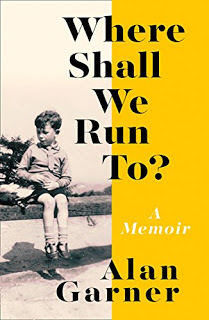 There is no doubt that Alan Garner is a remarkable writer, for whom a sense of place is absolutely central to his writing - so it's not entirely surprising that in this memoir of his childhood up to the age of 11 (with a couple of short articles from later years), the location where he was brought up - Alderley Edge - plays as much as part as his childhood friends and relations.
There is no doubt that Alan Garner is a remarkable writer, for whom a sense of place is absolutely central to his writing - so it's not entirely surprising that in this memoir of his childhood up to the age of 11 (with a couple of short articles from later years), the location where he was brought up - Alderley Edge - plays as much as part as his childhood friends and relations.This was not the Alderley Edge of the modern football star - the village from mid-1930s to mid-1940s was a typical large rural village of the period with the familiar combination of eccentrics and everyday occurrences. Garner was a sickly child, whose illnesses also have a major influence on what we read.
For such a sophisticated writer, there is a deceptively simple style, relating events in a way that seems not much different to the way the young Garner himself might have related them - relatively little pastoral description, far more on what happened, with a casual attitude to time that enables him to flit backwards and forward through those ten years or so. School features large, as does family, and the ever-present Edge itself.
My main disappointment as a reader is that, while Garner hints at his transition to grammar school, he stops the narration before arriving there. This fits entirely with his sense-of-place driven approach, but I went to the same grammar school, also from the school of a large village (though 20 years later, and from a Lancashire village) and I would have loved to have discovered his experiences in Manchester - perhaps (please) there will be a sequel.
It's a short book that would be possible to read in a single sitting and a delight that Garner fan, and many others would want to share.
Where Shall We Run To? is available from Amazon.co.uk and Amazon.com
Published on May 09, 2019 05:06
April 16, 2019
Dead Simple - Peter James.- review
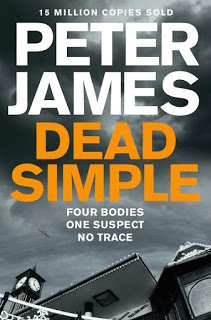 A good British crime novel is a wonderful thing, and I felt fairly confident coming to Dead Simple because according to the cover it has sold 14 million copies. But, for me, it was a huge let down.
A good British crime novel is a wonderful thing, and I felt fairly confident coming to Dead Simple because according to the cover it has sold 14 million copies. But, for me, it was a huge let down.Peter James manages a couple of interesting twists and turns along the way, which I presume accounts for those sales. But the characters are mostly two-dimensional, the plot is incredibly far fetched - and this is a world where mediums can solve crimes.
There are a couple of interesting ideas in the plot line, but the trouble is that James piles coincidence on unlikelihood to produce a ludicrously infeasible string of events. Add to this a deus ex machina ending dependent on a psychic's ability to exactly locate a missing person using a pendulum and a map (why do we bother with the police, when psychics could just solve all the crimes?) and the result is a book that convinces me not to take another step in the Roy Grace series.
I usually put links to Amazon at this point - but I can't see why I would.
Published on April 16, 2019 10:06
April 8, 2019
How statistics can be right but still misleading
 We are bombarded with statistics all the time in the news, on social media, from government and science. Sometimes they are very useful. At other times they are simply wrong. But there's an in-between way to use statistics - deliberately or otherwise - that is both accurate and misleading.
We are bombarded with statistics all the time in the news, on social media, from government and science. Sometimes they are very useful. At other times they are simply wrong. But there's an in-between way to use statistics - deliberately or otherwise - that is both accurate and misleading.I just want to give two examples, though there are many more out there. If you want to find out more about the use and misuse of statistics, I'd recommend my book Dice World on the impact of randomness, probability and statistics on our lives and David Spiegelhalter's book The Art of Statistics to get an introduction to how statistics are created, used and misused.
The first example is a deliberate attempt to mislead. The graphic at the top right has been circulated on Facebook. The idea is the this demonstrates the problem with Brexit by showing how important the EU is to us an export market. It doesn't matter if you agree or disagree with Brexit, the issue here is how the numbers are being used. I'd say there are three distortions here. The first is that it's perfectly possible to have Brexit and not to damage EU exports. Secondly, the numbers are bizarrely stated in US dollars - the only reason I can think for this is that it makes the EU amount seem bigger. Finally, there's the matter of the dog that didn't bark. Because around $350 billion of non-EU exports is missing. Bear in mind, I'm not saying the numbers are wrong - the EU is a hugely important market for the UK. But to omit around the same amount of non-EU exports as there are EU exports could only have been done to make the EU seem more important than it really is. That's bad, and clearly deliberate.
 More subtle is something that happened when it was announced that eating bacon increased your risk of bowel cancer. We saw headlines like this in the Guardian, pointing out that eating a couple of rashers of bacon a day 'would raise the risk of getting bowel cancer by 18% over a lifetime.' This is true, but with a huge proviso. That 'risk', which sounds terrifyingly huge, is a relative risk, not an absolute one. It's the increase in risk in what is a relatively low risk overall. If you turn that into an absolute risk - which is what most readers would expect - i.e. if I eat bacon every day what is the chance that it will give me cancer over my lifetime, the risk is not 18% but 1%. That feels rather different. It's still a risk - it's still important to know. But it's far more meaningful than the relative risk. Again, the statistics are accurate (though their interpretation may not be: former University College pharmacology professor David Colquhoun has argued strongly from earlier versions of the data that the interpretation is suspect because there is only weak evidence of causality) - but the way it is presented (either intentionally or accidentally) is highly misleading.
More subtle is something that happened when it was announced that eating bacon increased your risk of bowel cancer. We saw headlines like this in the Guardian, pointing out that eating a couple of rashers of bacon a day 'would raise the risk of getting bowel cancer by 18% over a lifetime.' This is true, but with a huge proviso. That 'risk', which sounds terrifyingly huge, is a relative risk, not an absolute one. It's the increase in risk in what is a relatively low risk overall. If you turn that into an absolute risk - which is what most readers would expect - i.e. if I eat bacon every day what is the chance that it will give me cancer over my lifetime, the risk is not 18% but 1%. That feels rather different. It's still a risk - it's still important to know. But it's far more meaningful than the relative risk. Again, the statistics are accurate (though their interpretation may not be: former University College pharmacology professor David Colquhoun has argued strongly from earlier versions of the data that the interpretation is suspect because there is only weak evidence of causality) - but the way it is presented (either intentionally or accidentally) is highly misleading.No one is saying we should ignore statistics. But we need to be careful about taking what we read in the papers (or even more so on social media) at face value. At the very least, if it's not possible to dig down and see where the numbers come from we should be highly suspicious.
Published on April 08, 2019 08:15
January 2, 2019
Two books with a social conscience - review
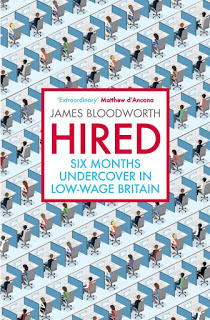 Purely by coincidence, I asked Father Christmas for two sort-of travel books with a social conscience, so it's handy to be able to review them both together.
Purely by coincidence, I asked Father Christmas for two sort-of travel books with a social conscience, so it's handy to be able to review them both together.The first I read was James Bloodworth's Hired. Rather like a modern version of Orwell's Road to Wigan Pier, Bloodworth's book describes six months 'undercover in low-wage Britain.' Bloodworth takes on jobs in an Amazon warehouse in Rugeley, as a care worker (sort of) in Blackpool, in a call centre in the South Wales Valleys and as an Uber driver in London.
His experiences provide valuable insights into the life that goes with these low wage jobs. The workers face two huge problems - not being paid enough to live on and oppressive working conditions, including zero hours contracts. The low pay was potentially the case in all the examples (in principle, the Uber driving could have produced a better return), while the conditions varied from the extremely iffy at Rugeley to pleasant enough at the Admiral call centre, where Bloodworth had to struggle to find anything to complain about other than a boring job and the company culture being a little too jolly.
The tasks at Rugeley and in Blackpool were also like to leave the worker so worn out that they had very little other life. At least, in principle this applied in Blackpool, as Bloodworth was never able to actually do the job because his Disclosure and Barring Service clearance did not come through in time for him to undertake the task, though he was able to shadow another worker for part of his time there.
Bloodworth does a good job in uncovering the reality of these jobs and the lives of those who undertake them. He claims that he is only observing and doesn't offer solutions, but in an epilogue does give a little thought to this. Suggestions (from here and elsewhere) of a realistic living wage, the ability to be unionised and end to zero hours contracts are straightforward and sensible. However, Bloodworth's analysis does skip over one thing that comes across glaringly in his account. This low wage economy is propped up by freedom of movement. Reading the book made me significantly more sympathetic to Jeremy Corbyn's viewpoint that leaving the EU would be beneficial because companies would have to pay more without a ready supply of low paid EU nationals to fill these posts. Of course that means more cost to consumers and taxpayers, but surely that is worthwhile to avoid such poor working conditions?
Will reading this book make me stop using the companies and services Bloodworth mentions? No - that would inconvenience me and wouldn't help the workers. But the picture it gives of these low pay jobs does encourage me to look to future governments for a better living wage and improved worker's rights.
Hired is (ironically) available from Amazon.co.uk and Amazon.com
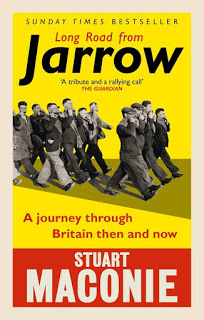 One thing that does come through, particularly in Bloodworth's coverage of Blackpool is another parallel with George Orwell - a touch of comfortable South-East driven disgust at the poor provincials. This certainly isn't the case in the other book I read, Stuart Maconie's Long Road from Jarrow. For me, Maconie has taken over from Bill Bryson as the doyen of humorous British travel writing. This title is a touch more serious than his previous ones, but still allows for his warmth and friendliness to come through. Maconie follows the path of the 1936 Jarrow march, when 200ish steelworkers marched to London to present a petition asking for government assistance in creating new jobs after their steelworks closed.
One thing that does come through, particularly in Bloodworth's coverage of Blackpool is another parallel with George Orwell - a touch of comfortable South-East driven disgust at the poor provincials. This certainly isn't the case in the other book I read, Stuart Maconie's Long Road from Jarrow. For me, Maconie has taken over from Bill Bryson as the doyen of humorous British travel writing. This title is a touch more serious than his previous ones, but still allows for his warmth and friendliness to come through. Maconie follows the path of the 1936 Jarrow march, when 200ish steelworkers marched to London to present a petition asking for government assistance in creating new jobs after their steelworks closed.Day by day, the book follows the stages of the march exactly 80 years on from the original. Maconie gives a mix of well-researched history, delving into the reality of a march that many will have heard of, but most only have a vague idea about (like many others, I associated it with mining and the depression of the 1920s), bringing in his own experiences on the walk. The timing of the book is also brilliant as he was able to include reflections on the Brexit vote in the UK and the American election of Donald Trump.
The only downside of the theme of the book is that Maconie does not have as much freedom to do as he wants - he has to stick to the daily schedule - as a result of which, there is rather less humour and social interaction than in his other books - but that sacrifice is well worth it. Whether he is revelling in diverse eating places along the way (Maconie says people complain he talks too much about food, but for me that's part of the charm of his writing), wryly commenting on socialist meetings he attends or reflecting on the Hillsborough disaster as he passes through Sheffield, Maconie is engaging and insightful. It's the kind of book where it's difficult to avoid sharing snippets with others in earshot.
One example of his insight that Bloodworth would have been unable to share was in his assessment of the reasons for Brexit. With a deep understanding of why Northerners in particular may feel a resentment that spilled over in a response to the Brexit vote that was unexpected from the comfortable metropolitan elite, Maconie is able to say why he is against Brexit - but also tearing apart the attitude of those who label Brexit supporters racist and ignorant. He clearly understands and explains the drivers for this decision.
However, as much as it features, this isn't a book about Brexit, and Maconie brings the story of the Jarrow Crusade alive, with its many unexpected twists and turns, whether it's a warm welcome for them from the establishment Ripon Cathedral (and Maconie's own delight at attending choral evensong) or the varied accommodation and receptions the marchers received along the way, including terrible treatment at Westminster, where their petition was practically ignored. Maconie manages to celebrate multicultural Britain now, while still being strongly aware of the very English nature of the march, the landscape and the social climate then and now. An excellent book.
Long Road from Jarrow is available from Amazon.co.uk and Amazon.com
Published on January 02, 2019 05:48
December 4, 2018
Canute and the High Street
 Hardly a week goes by without some report or newspaper article bemoaning the loss of traditional high street shopping. Everyone has an opinion on how to save the high street, from Mary Portas's ill-fated appointment as 'high street tsar' to the little-loved Mike Ashley's dire suggestion that the answer to the problem is to levy a 20% tax on online sales - which would simply make the consumer pay more but is unlikely to change shopping habits. I think it's time we took a lesson from King Canute.
Hardly a week goes by without some report or newspaper article bemoaning the loss of traditional high street shopping. Everyone has an opinion on how to save the high street, from Mary Portas's ill-fated appointment as 'high street tsar' to the little-loved Mike Ashley's dire suggestion that the answer to the problem is to levy a 20% tax on online sales - which would simply make the consumer pay more but is unlikely to change shopping habits. I think it's time we took a lesson from King Canute.For those not familiar with the legend of this tenth century king of Denmark, England and Norway more properly named Cnut, he is said to have tried to order the tide to stay off the beach. The tale tends to be presented these days with Cnut as fall guy, idiotically over-valuing his own ability, though it originally involved Cnut using his attempt as a demonstration to his courtiers that even a king is limited in his power compared with God's forces of nature.
I believe that all the failing attempts to bring shopping back to the high street entirely miss the point. There's a reason we shop online or in out-of-town shopping centres. Unless you live in the town centre, it's not a convenient place to shop. So rather than try to force us to do something we don't want to do, why not change what town centres are for? If instead we made it far easier to convert commercial premises into accommodation, we could see the high street becoming again what it was in the first place - primarily living accommodation with as much commercial use as it can sensibly support.
If you look above the shop windows at the buildings in a typical British high street you will usually see what used to be housing. (Take a look at the picture above.) These upper floors are now usually store rooms or, more often than not, simply not used at all. By converting the buildings back to accommodation we could see town centres attractive places to live again. And with more people living there, there will be more demand for town centre pubs, restaurants, coffee shops, theatres and cinemas. In turn these facilities may even result in so many people coming back into towns that town centre shops thrive once again. But the point is that by putting the focus on people, not propping up failing businesses, we would be driving the future of the high street from the right perspective.
Forget high street tsars and trying to punish online retailers and out of town malls. Let's give incentives instead to make high streets living communities once more.
Published on December 04, 2018 07:02
October 12, 2018
The smart meter swindle
 I was mildly irritated by an advert for smart meters in my newspaper, placed by ‘The campaign for a smarter Britain.’ It claimed ‘If we all had a smart meter, the CO2 savings would be like planting more than 10 million trees a year.’ Note this says would not could - a claim that cannot be factual. The ad even emphasises this by having small print saying ‘Savings possible by customers measuring energy use and cutting waste.’ Possible is true, would be isn’t.
I was mildly irritated by an advert for smart meters in my newspaper, placed by ‘The campaign for a smarter Britain.’ It claimed ‘If we all had a smart meter, the CO2 savings would be like planting more than 10 million trees a year.’ Note this says would not could - a claim that cannot be factual. The ad even emphasises this by having small print saying ‘Savings possible by customers measuring energy use and cutting waste.’ Possible is true, would be isn’t.What the ad doesn’t point out is that exactly the same savings are possible without smart meters if people cut back on their energy use. It's entirely possible that everything the smart meter could achieve in energy savings could also be obtained by giving customers a laminated card with a priority list for things to switch off to save energy. At a tiny fraction of the cost.
In practice, smart meters are being pushed by the energy companies for two reasons. One is that they can save money by not employing meter readers. And the second is that they can introduce complex tariffs that charge more in peak periods, making billing much harder to understand and preventing users from getting the best deal.
Simples.
This has been a Green Heretic production.
Published on October 12, 2018 00:25



